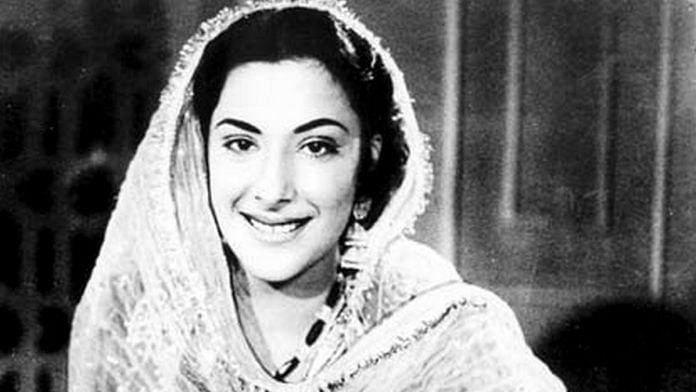New Delhi: Gap-toothed beauty Nargis Dutt, who graced the silver screen from the 1940s to ‘60s, has often been described as a legend. After all, there is a category in the National Film Awards named the ‘Nargis Dutt Award’ in her honour.
The first Indian actress to receive a Padma Shri award, Nargis featured in 51 films including Mother India, Barsaat, Shree 420 and Andaz. And yet her end was a lot more grim than her beginnings.
Nargis died of pancreatic cancer in 1981, just days before the release of Rocky, her son, Sanjay Dutt’s first movie. She was 51 years old and left behind a substantive body of work that proved she could play both a royal persona in an epic like Humayun and a spoiled cosmopolitan girl like in Andaz. But Nargis had range not just on screen, but off it as well.
At the peak of her fame, she gave up acting to raise a family and ended up dedicating her life to the cause of spastic children. Her charitable work earned her a seat in the Rajya Sabha in 1980. The Nargis Dutt Foundation, instituted in her honour, has been working in the field of health, education and women’s empowerment for the past 40 years.
On the star’s 39th death anniversary, ThePrint takes a look at her journey from actor to cultural icon.
Also read: With Bobby, Rishi Kapoor and Dimple Kapadia set the bar for young love in Bollywood
From tomboy to on-screen legend
Born Fatima Rashid on 1 June 1929, in Allahabad, she was someone in whose home “art was the way of life”. Her mother was a renowned classical singer, Jaddanbai, and her father belonged to an affluent family of Rawalpindi. The family briefly moved to Calcutta before settling down in Bombay. Young Nargis was what people then called a tomboy and loved playing badminton, but perhaps the first sign of her acting chops was in school plays at Queen Mary’s.
Nargis was steered into acting by her mother at a very young age. She made her debut at 4 in a film called Talashe Haq which her mother produced and curated music for. It’s no surprise that Nargis’ brother, Anwar Hussain also took up the craft.
But it was Mehboob Khan’s Mother India (1957) that put her on the map and it was Khan who suggested her stage name. In the film, she played Radha, a poor woman determined to raise her children despite hardships and social exploitation, who ends up killing her son, a bandit and sexual harasser (played by her future husband, Sunil Dutt). It won her a Filmfare Award for Best Actress in 1958 and became the first Indian film to be nominated for the Academy Awards.
Incidentally, it was on the set of this film that Sunil Dutt rescued her from a fire. Her on and off relationship with actor and filmmaker Raj Kapoor was the subject of some talk, and his son, the late Rishi Kapoor, even wrote about it in his memoir, Khullam Khulla.
Mothering was in her nature
In an interview with Simi Garewal, Sunil Dutt revealed that Nargis used to call him her “biggest Baby”. She extended the same care to many film crews she would work with. As one crew member recalls in her biographical documentary, Nargis would nag them about eating well and sleeping early.
The two raised three children – Sanjay, who became an actor, Priya, who joined the Congress party and Namrata, who has shied away from the limelight throughout her life. Sanjay, the eldest, was the “most pampered”. However, according to Yaseer Usman’s book Sanjay Dutt: The Crazy Untold Story of Bollywood’s Bad Boy, the middle child, Namrata remembers, “Mom sometimes got angry with Sanjay. She’d spew expletives like suwar, ullu, gadha and even threw a chappal at him.”
According to Priya, Nargis knew about Sanjay’s drug addiction during his youth “but didn’t want to accept it”. Her death left a lasting impact on him considering she passed three days before the launch of his first film, Rocky. At the premier, there was a chair left empty in her honour, recalled Sunil.
Dedicated to the cause of spastic children
Nargis became the first patron of the Spastic Society of India in 1973 and in her biographical documentary, you can see her visit to the first clinic – playfully interacting with children and teaching them one-on-one. According to Mithu Alur, founder of the Spastic Society of India, Nargis told her she “always wanted to be a doctor and do medicine…but didn’t have the opportunity”. After her death, Sunil Dutt funded the Spastic Society. Little is known of what has become of the patronage since his death in 2005.
Priya has carried on the legacy of the Nargis Dutt Foundation, set up by Sunil in 1981, which has successfully set up medical camps across India and mobile clinics in slums. The actor’s battle with cancer also birthed the Nargis Dutt Memorial Cancer Foundation in 1982.
From the long list of honours and establishments set up in her memory, it’s safe to say Nargis has been immortalised. An actor, a mother, a social worker and a woman driven by compassion – the mark she left behind is yet to fade.
Also read: Loverboy, brat, troubled star, outspoken patriarch — Rishi Kapoor was all of these and more






